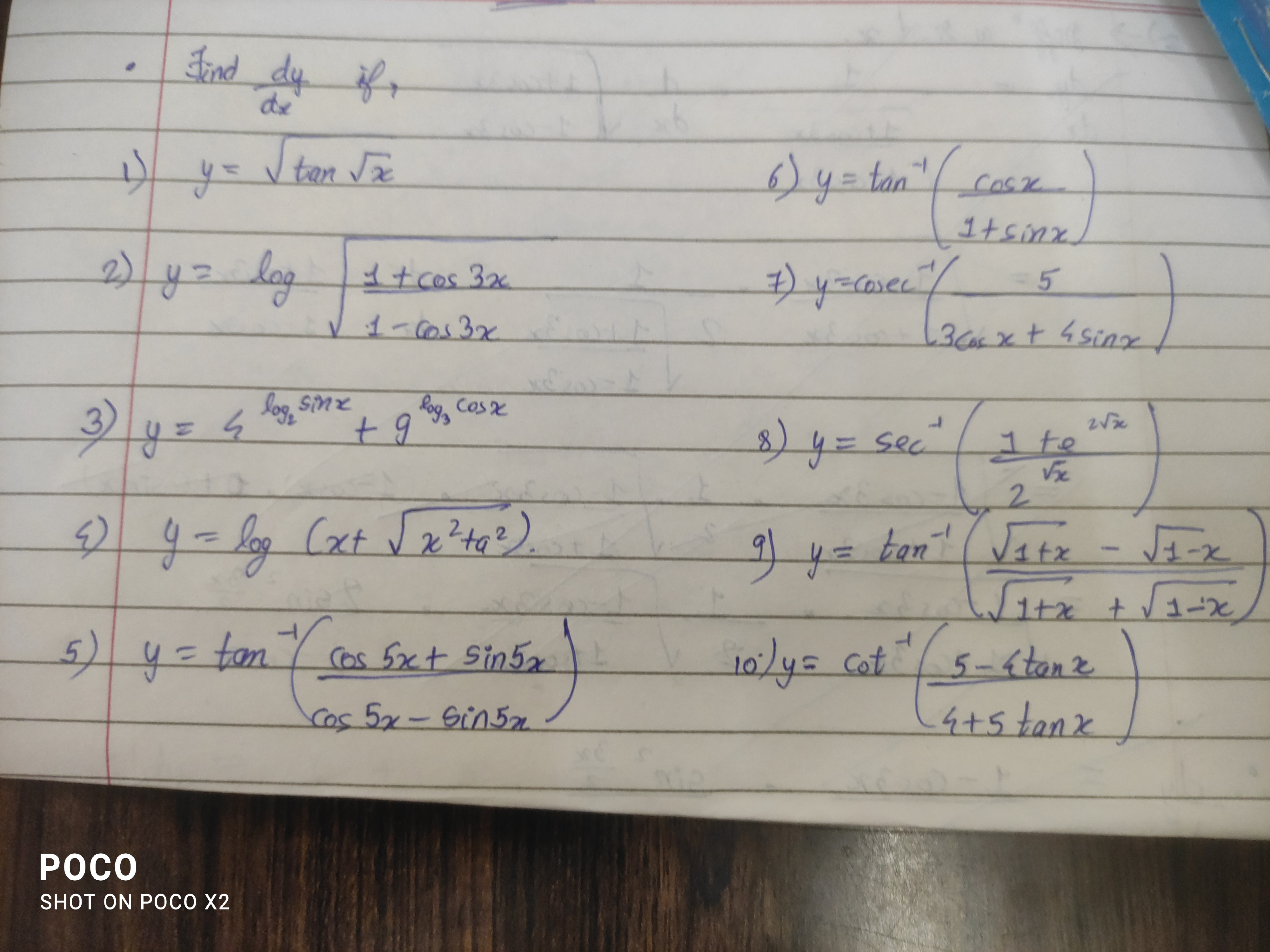Question
Question: - Find $\frac{dy}{dx}$ if, 1) $y=\sqrt{tan\sqrt{x}}$ 6) $y=tan^{-1}(\frac{cosx}{1+sinx})$ 2) $y=log...
- Find dxdy if,
- y=tanx
- y=tan−1(1+sinxcosx)
- y=log1−cos3x1+cos3x
- y=cosec−1(3cosx+4sinx5)
- y=4log2sinx+9log3cosx
- y=sec−1(21+xe2x)
- y=log(x+x2+a2).
- y=tan−1(1+x+1−x1+x−1−x)
- y=tan−1(cos5x−sin5xcos5x+sin5x)
- y=cot−1(4+5tanx5−4tanx)

See explanation for derivatives of each function.
Solution
Below are the derivatives for each given function:
-
dxdy=4xtanxsec2x
-
dxdy=−sin3x3
-
dxdy=0
-
dxdy=x2+a21
-
dxdy=5
-
dxdy=−21
-
dxdy=1
-
dxdy=21+xe2x(21+xe2x)2−12xe2x−4x3/2e2x
-
dxdy=21−x21
-
dxdy=1
Detailed Solutions:
(1) Given:
y=tanx=(tanx)1/2Differentiate using the chain‐rule:
dxdy=21(tanx)−1/2⋅sec2x⋅dxd(x)=21(tanx)−1/2⋅sec2x⋅2x1Thus,
dxdy=4xtanxsec2x(2) Given:
y=log1−cos3x1+cos3x=21ln(1−cos3x1+cos3x)Differentiate:
dxdy=21[dxdln(1+cos3x)−dxdln(1−cos3x)]Since dxdcos3x=−3sin3x, we have
dxdy=21[1+cos3x−3sin3x−1−cos3x3sin3x]=−23sin3x[1+cos3x1+1−cos3x1]Combine the two fractions:
1+cos3x1+1−cos3x1=1−cos23x(1−cos3x)+(1+cos3x)=sin23x2(since 1−cos23x=sin23x)Therefore,
dxdy=−23sin3x⋅sin23x2=−sin3x3Thus,
dxdy=−sin3x3(3) Given:
y=4log2(sinx)+9log3(cosx)Use the identity alogbc=clogba. Note that
4log2(sinx)=(sinx)log24=(sinx)2,since log24=2,and
9log3(cosx)=(cosx)log39=(cosx)2,since log39=2.Thus,
y=sin2x+cos2x=1⇒dxdy=0.So,
dxdy=0(4) Given:
y=log(x+x2+a2)Differentiate:
dxdy=x+x2+a21(1+x2+a2x)=x2+a21.Thus,
dxdy=x2+a21(5) Given:
y=tan−1(cos5x−sin5xcos5x+sin5x)Notice that writing in terms of tangent:
cos5x−sin5xcos5x+sin5x=1−tan5x1+tan5x=tan(5x+4π)Thus,
y=tan−1(tan(5x+4π))=5x+4π(within the principal value)Differentiate:
dxdy=5(6) Given:
y=tan−1(1+sinxcosx)Express in half-angle form. Write t=tan2x. Then using the half-angle formulas:
sinx=1+t22t,cosx=1+t21−t2it can be shown that
1+sinxcosx=1+t1−t=tan(4π−2x)Thus,
y=tan−1(tan(4π−2x))=4π−2xDifferentiate:
dxdy=−21(7) Given:
y=csc−1(3cosx+4sinx5)Recognize that 3cosx+4sinx can be written as 5sin(x+α) where
sinα=53,cosα=54(α=sin−1(3/5)).Thus,
3cosx+4sinx5=5sin(x+α)5=csc(x+α)and so
y=csc−1(csc(x+α))=x+α,up to the principal branch. Therefore,
dxdy=1(8) Given:
y=sec−1(21+xe2x)Let
u(x)=21+xe2x.The derivative formula for y=sec−1(u) is
dxdy=∣u(x)∣u(x)2−1u′(x).To find u′(x), first write:
u(x)=21+21xe2x.Differentiate the second term using the product (or quotient) rule. Writing it as
v(x)=e2xx−1/2,its derivative is:
v′(x)=x−1/2⋅dxd(e2x)+e2x⋅dxd(x−1/2).Since
dxd(e2x)=e2x⋅dxd(2x)=e2x⋅x1,and
dxd(x−1/2)=−21x−3/2,we get
v′(x)=xe2x+(−2x3/2e2x)=xe2x−2x3/2e2x.Thus,
u′(x)=21v′(x)=2xe2x−4x3/2e2x.Finally, the derivative is:
dxdy=21+xe2x(21+xe2x)2−12xe2x−4x3/2e2x.(One may leave the answer in this implicit form.)
(9) Given:
y=tan−1(1+x+1−x1+x−1−x)A known identity shows that
tan−1(1+x+1−x1+x−1−x)=21sin−1x.Differentiate:
dxdy=21⋅1−x21=21−x21.(10) Given:
y=cot−1(4+5tanx5−4tanx)Express in terms of tan−1 by using the identity cot−1(z)=tan−1(1/z):
y=tan−1(5−4tanx4+5tanx).Notice that
tan(x+θ)=1−tanxtanθtanx+tanθ.Choosing tanθ=54 we have:
tan(x+tan−154)=1−tanx54tanx+54=5−4tanx5tanx+4,which matches the expression. Therefore,
y=x+tan−154⇒dxdy=1.Thus,
dxdy=1.